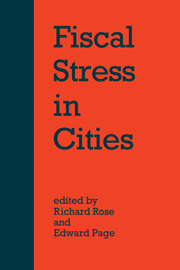Book contents
- Frontmatter
- Contents
- Acknowledgments
- 1 Can Government Control Itself?
- 2 Pressures in Whitehall
- 3 Pressures from Whitehall
- 4 The Decline of Urban Economies
- 5 Local Government as an Employer
- 6 Do Fewer Pupils Mean Falling Expenditure?
- 7 Local Autonomy and Intergovernmental Finance in Britain and the United States
- 8 Chronic Instability in Fiscal Systems
2 - Pressures in Whitehall
Published online by Cambridge University Press: 07 October 2011
- Frontmatter
- Contents
- Acknowledgments
- 1 Can Government Control Itself?
- 2 Pressures in Whitehall
- 3 Pressures from Whitehall
- 4 The Decline of Urban Economies
- 5 Local Government as an Employer
- 6 Do Fewer Pupils Mean Falling Expenditure?
- 7 Local Autonomy and Intergovernmental Finance in Britain and the United States
- 8 Chronic Instability in Fiscal Systems
Summary
In the last decade no spending authority has been insulated from pressure to cut expenditure. However, experience of that pressure and the reaction to it has varied between levels of government and between organisations within levels. Pressures on local government have been heavier and more continuous than those experienced by central government or other parts of the public sector. As a result, the level of local authority expenditure has declined both in real terms and as a proportion of total public expenditure. In 1975–6, local authority current and capital spending accounted for nearly one-third of total public expenditure; by 1980–1 that share was down to one-quarter. Moreover, in this period, total local authority expenditure declined by more than 16 per cent in real terms, with a further sharp fall in 1981–2.
Some of the pressures on local authorities to cut their spending result from change in the political control of local councils; other pressures arise from the inadequacy of local taxation in a period of high inflation. There are also pressures from central spending departments, like the Department of the Environment (DoE), the Department of Transport, and the Department of Education and Science, who themselves are subject to pressure from the Treasury and the former Civil Service Department (CSD). The pressures from Whitehall are particularly potent since Treasury grants form a large proportion of total local government income. In addition, the centre has enacted laws to strengthen its hand in central-local fiscal relations (see chapter 3).
- Type
- Chapter
- Information
- Fiscal Stress in Cities , pp. 17 - 43Publisher: Cambridge University PressPrint publication year: 1983

